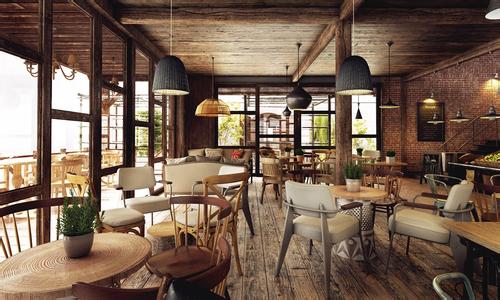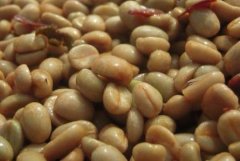A brief introduction to the cultivation of nutty boutique coffee in Uganda, geographical location, climate and altitude

Indonesia's Java, Sulawesi and New Guinea all produce beans, and the IJEN highlands in eastern Java are also very good at washing beans.
The coffee growing industry in Uganda is one of the pillar industries of its exports. Uganda is the birthplace of Robsta in Africa, just as Ethiopia is the origin of Arabica coffee, while Robster coffee was first discovered in Uganda. So far, Uganda has a history of growing coffee for more than 100 years. The output ranks second in Africa, after Ethiopia. At the same time, Uganda is one of the few major countries in Africa dedicated to the production of organic coffee. In Uganda (Uganda), Arabica coffee beans account for only 15% of the country's total coffee production. Uganda's best coffee is mainly produced in the mountains of Elgon and Bugisu along the Kenyan border in the northeast and Ruwensori in the west.
AA: this is a more common grade. Coffee beans are larger in size and have a particle size higher than 18 mesh or 7.22mm. This kind of beans usually get the highest price.
Uganda's coffee production ranks first in Africa, accounting for more than 70% of its total exports. Uganda is also the hometown and main producing area of Robes specialty coffee. In the 1960s, Ugandan coffee production remained at 3.5 million bags a year. By the mid-1980s, coffee production had dropped to 2.5 million bags a year, mainly for political reasons. But now coffee production is on the rise again, currently about 3 million bags a year. Mainly exported to the European Union, of which Sweden, Italy and other countries are its largest coffee buyers, the Republic of Uganda, located in eastern Africa, is a cross-equatorial landlocked country. Uganda is bordered by Sudan to the north, Kenya to the east, Lake Victoria to the southwest, Tanzania and Rwanda to the south, and Congo to the west.
The territory is located between the east and west branches of the East African Rift Valley, tilting gently from west to middle and low and flat in the south. Margarita Peak is 5109 meters above sea level, which is the highest peak in the country. There are many rivers and lakes and a large water area, so Uganda is known as "plateau water village" and "Pearl of East Africa". Lake Victoria is the second largest freshwater lake in the world and Africa, accounting for 43% of Uganda's territorial area. The White Nile (White Nile), which flows from Lake Victoria, flows through most of the country. Its unique scenery includes tropical forests and tea trees on the snow-covered slopes of Mount Ruwenzori Mountains, dry plants in Karamoja, rolling savannas in Acholi, Bunyoro, Tororo and Ankole, and fertile cotton fields in Teso. Tropical climate. Because of the high terrain, most areas are warm all the year round. The average annual rainfall is 1 000 mm. Agriculture is the main pillar of the country's economy. The population of agriculture and animal husbandry accounts for 90% of the country. Crops include plantains, cassava, millet, sorghum, corn and so on.
Mbale on the eastern side of the Elgang Mountains and other producing areas on the western side near the border of the Democratic Republic of the Congo have the export name Wugar. The official ranks are Oaganic (Organic), Bugisu AA, Bugisu A, Bugisu B, Bugisu PB, Wugar, Drugar and other unlisted grades. To find Ugandan coffee with good performance, you must first recognize the three grades of BugisuAA, An and PB, but because the country is inland and has many transportation problems, it often comes to raw beans with low moisture content and not emerald green appearance, but Ugandan coffee is not a type of coffee that emphasizes aroma, as long as the raw beans are not and turn 100 or yellowed, they can generally have a good flavor performance in the producing areas. It has a low ripe fruit aroma, such as the taste of red wine, and a thick mellow thickness, which is similar to some Kenyan beans with low tonality, but with a mild soil flavor, so it is quite different from other East African countries in flavor characteristics. on the contrary, it is a bit similar to Asia, Indonesia, Sulawesi? Tonaga coffee and Java state-owned manor coffee. The baking degree between City+ and Full City+ is all better.
● Santos NO2, Brazil (Brazilian Santos NO2)
The fragrance is soft, gentle and unique, with a smooth taste, originating from one of the largest coffee producers in the world.
Moderate acidity, rich and body, mild, unique and smooth flavor.
Adult beans with adzuki beans (17-18 / 64 inches) are more beautiful and taste more perfect than soybeans (19/64FCS). Full and smooth. Compared with soybeans, the taste of "old age" is a little lower! It's also very good! Dry cleaning! If you are lucky enough to find Brazilian manor beans, you will appreciate the apple flavor! (it's hard to meet.)
● Columbia Premium (Colombian Supremo)
Moderate acidity, medium mellow, sweet and smooth, aroma, nutty, finish with a hint of chocolate.
Good acidity, moderate body, really sweet, nutty aroma with smooth, rich flavor.
Colombian coffee beans are very good, alpine (volcanic rock-rich, fertile soil) washed coffee beans, uniform size is the best in Colombia!
● Innesia, Sumatra, Manning (Sumatran Mandheling)
Very full-bodied, low acidity, with unique nutty and floral aromas.
Uniqely, heavy body, low acidity, pleasant nutty aroma, distinctive, syrupy, exotic flavor
Indonesia's Sumanda wax island producing area is famous for its Mantenin GR1 (Class I), (rare gold mantenin is rare) semi-washed Semi-wash, raw beans are usually slightly blue, soft, famous for Soft Bean.
Important Notice :
前街咖啡 FrontStreet Coffee has moved to new addredd:
FrontStreet Coffee Address: 315,Donghua East Road,GuangZhou
Tel:020 38364473
- Prev

A brief introduction to the Market Price of simple and mild Uganda Fine Coffee Bean varieties
Mbale on the eastern side of Mount Elgon and other producing areas on the western side near the border of the Democratic Republic of the Congo have the export name Wugar. The official ranks are Oaganic (Organic), Bugisu AA, Bugisu A, Bugisu B, Bugisu PB, Wugar, Drugar and other unlisted grades. To find a good Ugandan coffee, you must first recognize BugisuAA and A.
- Next

Brief introduction to the treatment method of Grinding degree and Baking degree of Fine Coffee beans in Xipi Waterfall, Uganda
The livelihood of 25% of the population is closely related to coffee production. About 500000 farms grow coffee, but mainly Robster. Robusta accounts for 90% of coffee production, and the remaining 1 is Arabica coffee. Arabica and Robusta harvest only a small amount of Arabica beans in Java from October to February of the following year, and most of them have not been produced since the rust disaster.
Related
- Detailed explanation of Jadeite planting Land in Panamanian Jadeite Manor introduction to the grading system of Jadeite competitive bidding, Red bid, Green bid and Rose Summer
- Story of Coffee planting in Brenka region of Costa Rica Stonehenge Manor anaerobic heavy honey treatment of flavor mouth
- What's on the barrel of Blue Mountain Coffee beans?
- Can American coffee also pull flowers? How to use hot American style to pull out a good-looking pattern?
- Can you make a cold extract with coffee beans? What is the right proportion for cold-extracted coffee formula?
- Indonesian PWN Gold Mandrine Coffee Origin Features Flavor How to Chong? Mandolin coffee is American.
- A brief introduction to the flavor characteristics of Brazilian yellow bourbon coffee beans
- What is the effect of different water quality on the flavor of cold-extracted coffee? What kind of water is best for brewing coffee?
- Why do you think of Rose Summer whenever you mention Panamanian coffee?
- Introduction to the characteristics of authentic blue mountain coffee bean producing areas? What is the CIB Coffee Authority in Jamaica?

